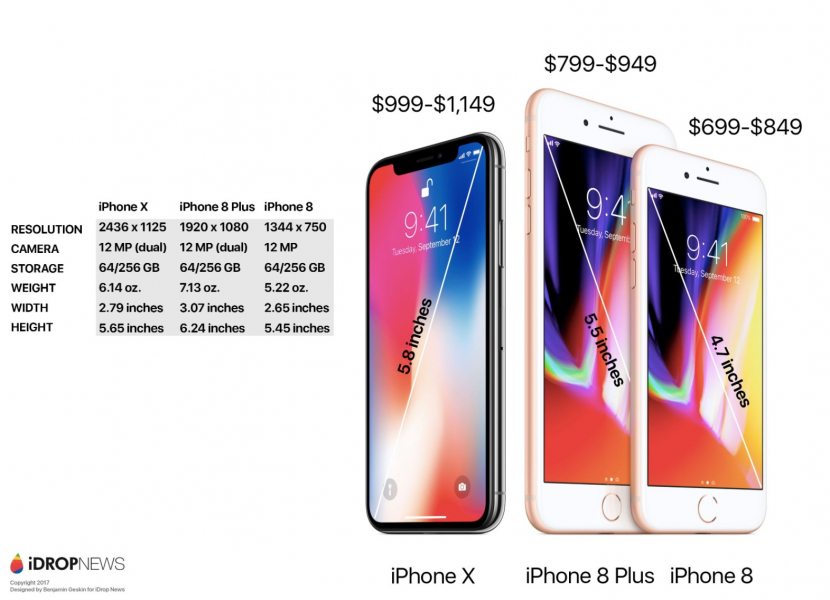Premium iPhone X Revealed with Super Retina OLED, Face ID, Gesture Controls + More

Image via Apple
Toggle Dark Mode
Apple’s premium OLED iPhone is finally here.
The company announced the iPhone X (pronounced iPhone “10”) during its fall announcement event on Tuesday, Sept. 12. Apple CEO Tim Cook called the device the “biggest leap forward since the original iPhone.” Indeed, the device introduces a slew of revolutionary new features and a completely revamped user experience. Here’s everything you need to know.
iPhone X Edge-to-Edge Display
In the words of Apple SVP Phill Schiller, the iPhone X is “all screen.” The device sports an edge-to-edge custom OLED display that measures 5.8 inches on the diagonal. The screen takes up basically the entire front of the new iPhone, save for tiny bezels around its edges and the camera cutout at the top. That means it packs the same display size as a Plus-model iPhone into a form factor that’s closer in size to a standard iPhone.

But beyond its size, the iPhone X’s display introduces a number of innovative tech. Apple calls it its “Super Retina Display,” and says it combines all of the benefits of an OLED screen with the brightness and color accuracy of its LCD-based Retina displays. It has a resolution of 2436×1125, supports HDR, and manages to pack in over 2.7 million pixels.
Like the iPhone 8 and iPhone 8 Plus also announced today, the iPhone X’s display sports Apple’s integrated 3D touch system, as well as its True Tone technology — which automatically adjusts the display’s color balance for a better viewing experience.
Construction-wise, the iPhone X uses a glass sandwich design (which allows for wireless charging) and sports a stainless steel band that blends seamlessly into the glass panels.
Gesture-Based Controls in Place of Home button
Like many predictions noted, the iPhone X also does away with the Home button. In its place, Apple has introduced a new gesture-based control system. To unlock the device, a user simply has to swipe up from the bottom of the display. When in an app, the same motion will return the user to the Home screen. A swipe-up-and-pause will bring up the iPhone’s multitasking pane.
Other Home button actions, like invoking Siri and the shortcut to bring up Apple Pay, have also been remapped. A long press on the side button will activate Siri, and a double-click is the new shortcut for Apple Pay. The Control Center is now activated via a swipe-down from the statusbar.
Face ID
With the removal of the Home button, Apple has also nixed Touch ID on the iPhone X. In its place, the company debuted a cutting-edge new biometric system called Face ID. The system’s underlying tech is complicated, but it relies on a suite of sensors stored in the company’s new True Depth Camera system (located in the sensor “notch”), as well as a new neural engine built into the phone’s CPU.
Face ID works by creating a mesh of your face with thousands of projected infrared “dots.” The system then takes an IR image to match your face to the face on file. The system works in light or dark environments or even when a user has glasses on. It also learns and adapts to a user’s face over time, so it works even if they decide to change hairstyles or grow a beard.
All facial recognition data is stored locally on the device — it’s never sent to a server. And Apple said the system is much more secure than Touch ID, and that it will be spoof-proof (unlike other facial recognition platforms). Its security allows it to be used for all Apple Pay transactions, as well.
It’s not all serious business, however. Apple has used the facial mapping technology to create a new type of animated emoji called Animoji. These new Animoji will mimic your facial expressions, allowing you to send custom animated emoji to your friends.
iPhone X Beefed-Up Internals, Camera and Battery
The device sports Apple’s new powerful A11 Bionic CPU, as well as the same suite of upgraded and proprietary internals as the iPhone 8 and iPhone 8 Plus. That includes an Apple-designed GPU and other chips. As far as water resistance, the device is IP67 rated.
The camera is also seriously upgraded, with wider sensors, faster apertures and enhanced low-light zoom. The rear-facing, dual-camera suite houses two 12-megapixel cameras — both with optical image stabilization. The 7MP selfie camera has also been given a boost, with support for both Portrait Mode and the newly announced Portrait Lighting mode. Both cameras should also allow for much better augmented reality experiences.
iPhone X’s battery has also gotten an upgrade. While Apple didn’t specify any new battery technology (like an L-shaped battery), the company did say that it will last two hours longer than the iPhone 7. The iPhone X will also support Qi standard wireless charging, like its iPhone 8 stablemates.
iPhone X Release Date and Pricing
The iPhone X will be available in Space Gray and Silver at launch. Like the iPhone 8 and iPhone 8 Plus, it’ll also come in 64GB and 256GB configurations.
The premium device will start at $999. The iPhone X will become available for pre-order on Oct. 27 before shipping to customers starting Nov. 3.






